What Is the Carbon Footprint of Fossil Fuels? A Life-Cycle Assessment
Impactful Ninja is reader-supported. When you buy through links on our site, we may earn an affiliate commission.
Learn more
Learn more
.
Hey fellow impactful ninja ? You may have noticed that Impactful Ninja is all about providing helpful information to make a positive impact on the world and society. And that we love to link back to where we found all the information for each of our posts. Most of these links are informational-based for you to check out their primary sources with one click. But some of these links are so-called "affiliate links" to products that we recommend. First and foremost, because we believe that they add value to you. For example, when we wrote a post about the environmental impact of long showers, we came across an EPA recommendation to use WaterSense showerheads. So we linked to where you can find them. Or, for many of our posts, we also link to our favorite books on that topic so that you can get a much more holistic overview than one single blog post could provide. And when there is an affiliate program for these products, we sign up for it. For example, as Amazon Associates, we earn from qualifying purchases. First, and most importantly, we still only recommend products that we believe add value for you. When you buy something through one of our affiliate links, we may earn a small commission - but at no additional costs to you. And when you buy something through a link that is not an affiliate link, we won’t receive any commission but we’ll still be happy to have helped you. When we find products that we believe add value to you and the seller has an affiliate program, we sign up for it. When you buy something through one of our affiliate links, we may earn a small commission (at no extra costs to you). And at this point in time, all money is reinvested in sharing the most helpful content with you. This includes all operating costs for running this site and the content creation itself. You may have noticed by the way Impactful Ninja is operated that money is not the driving factor behind it. It is a passion project of mine and I love to share helpful information with you to make a positive impact on the world and society. However, it's a project in that I invest a lot of time and also quite some money. Eventually, my dream is to one day turn this passion project into my full-time job and provide even more helpful information. But that's still a long time to go. Stay impactful,Affiliate Disclosure
Why do we add these product links?
What do these affiliate links mean for you?
What do these affiliate links mean for us?
What does this mean for me personally?
![]()
Fossil fuels (coal, oil, and natural gas) are the world’s primary energy source. But they are also responsible for emitting billions of tons of CO2 emissions into our atmosphere every year. So, we had to ask: What is the carbon footprint of fossil fuels?
Fossil fuels have some of the highest carbon footprints. Per kWh produced, oil emits 970, coal 820, and natural gas 490 grams of carbon dioxide on a life-cycle basis. They directly contribute to climate change, have various negative environmental effects, and are considered dirty energies.
Keep reading to learn about the overall carbon footprint of fossil fuels and their carbon footprint throughout their life cycles.
Here’s How We Assessed the Carbon Footprint of Fossil Fuels
The carbon footprint is one of the ways we measure the effects of human-induced global climate change. It primarily focuses on the greenhouse gas (GHG) emissions associated with consumption, but also includes other emissions such as CH4, nitrous oxide, and chlorofluorocarbons.
“Carbon footprint: the amount of greenhouse gases and specifically carbon dioxide emitted by something (such as a person’s activities or a product’s manufacture and transport) during a given period”
Merriam Webster
Basically, it is the amount of carbon emitted by an activity or an organization. This includes GHG emissions from fuel that we burn directly (e.g., heating a home, driving a car) and GHG emissions from manufacturing the products that we use (e.g., power plants, factories, and landfills).
Fossil fuels have powered our businesses, cars, and lights for over a century, today providing for over 80% of our energy. They consist of coal, oil, and natural gas (NG), all of which were formed millions of years ago.
Plant and animal remains gradually built up on the earth’s surface and the ocean floor, mixing with sand, silt, and calcium carbonate. Under immense heat and pressure, some of these remains were converted into coal, some into oil, and some into NG depending on the combination of organic matter present, how long it was buried, and pressure conditions.
“Fossil fuel: fuels, such as gas, coal, and oil, that were formed underground from plant and animal remains millions of years ago”
Cambridge Dictionary
There are three main types of fossil fuels: oil, coal, and natural gas (NG)
To understand the carbon footprint of all energy types, we must assess their life-cycle and each stage’s carbon footprint. This life-cycle assessment (LCA) is a method to evaluate the environmental impacts of products and materials. Over the years, companies have strategically used LCA to research and create more sustainable products. So, we had a look at the LCA for all three types of fossil fuels! (No worries, we’ll link back to each throughout this article.)
This Is the Carbon Footprint of All 3 Types of Fossil Fuels
When discussing the carbon footprint of certain energy types, we must take into account carbon emissions across the energy’s building, operating, and building back phases.
Fossil fuels are considered dirty energy because of their carbon footprint. On a life-cycle basis, oil emits 970 grams of CO2 equivalent per kWh (gCO2/KWh), which is the highest out of all of the fuel types. Coal emits 820 grams of carbon dioxide (CO2) equivalent per kWh, the second-highest. And NG emits 490 grams of CO2 equivalent per kWh, the third-highest out of all of the fuel types, but the lowest out of the three fossil fuels.
| Type of Fossil Fuel | Carbon Footprint |
| Oil | 970 gCO2/KWh |
| Coal | 820 gCO2/KWh |
| Natural Gas (NG) | 490 gCO2/KWh |
Have a look at the illustration below to see the average life-cycle CO2 equivalent emissions of fossil fuels and how they compare to the other energy types.

The world collectively emitted 14.36 billion tons (bt) of CO2 from coal, 12.36 bt from oil, and 7.62 bt from NG in 2019.
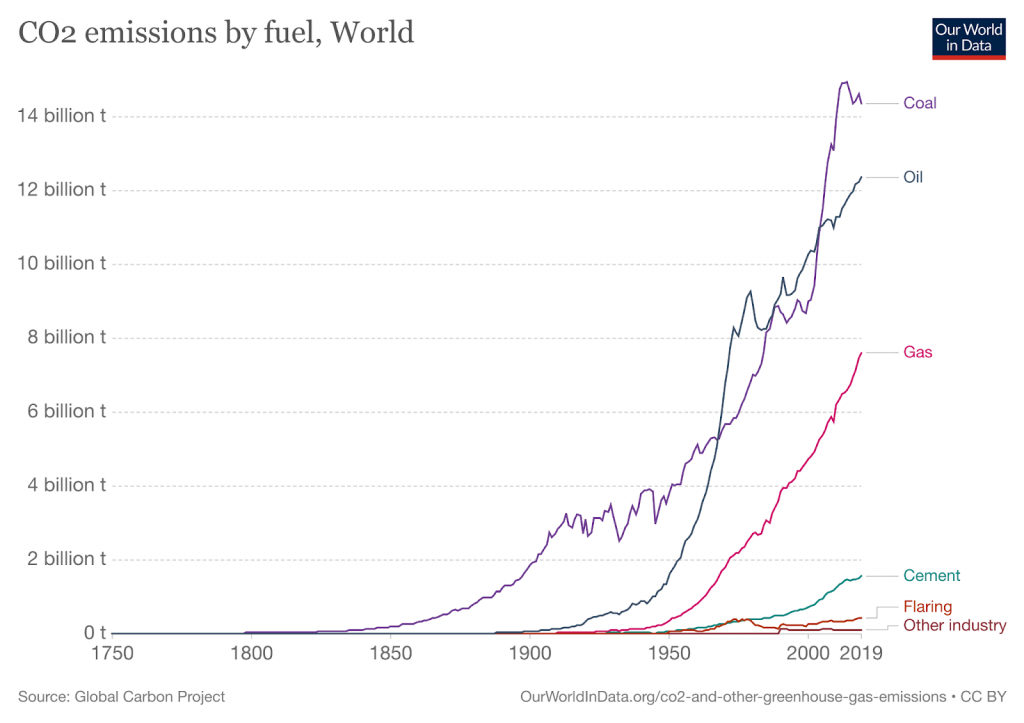
Fossil fuel (oil, coal, NG) consumption began with the Industrial Revolution, and consumption has increased exponentially over the past 70 years. The type of fuel we consume has shifted from solely coal, to coal and oil, and lastly to coal, oil, and NG.
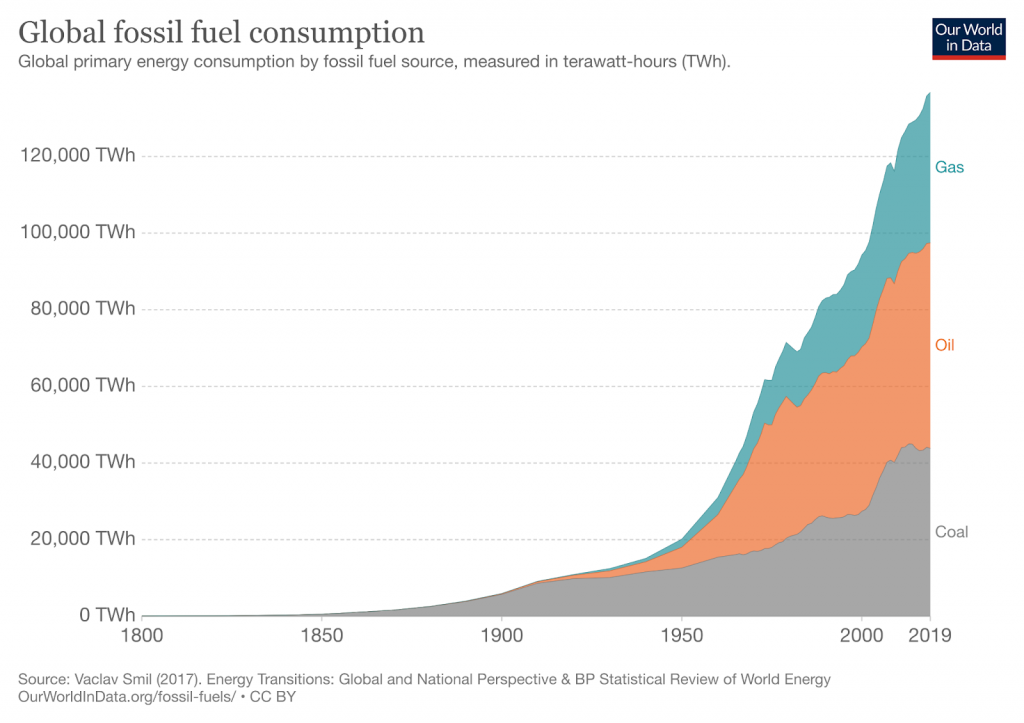
- 477 million tonnes (432.7 million tons) of coal were consumed in the US alone in 2020. This represents around 10% of total US energy consumption.
- 18.12 million barrels per day (b/d) of oil were consumed in the US alone in 2020. This represents around 24% of total US energy consumption. In terms of total petroleum consumption, gasoline represented 44%, distillates 21%, hydrocarbon gas liquids (HGLs) 18%, and jet fuel 6%.
- 30.5 trillion cubic feet (Tcf) of NG were consumed in the US alone in 2020. This represents around 34% of total US energy consumption.
When breaking it down into the three categories of fossil fuels, the US is the top producer of both oil and NG while China produces the most coal.
The top 6 fossil fuel producing countries in the world are:
- US
- Russia
- Iran
- Canada
- Qatar
- China
Because fossil fuel consumption makes up the majority of our electricity generation, it is important to understand what their carbon footprints are and how their carbon emissions affect the global climate change process.
Oil Energy Has the Highest Carbon Footprint at 970 Grams of CO2/kWh on a Life-Cycle Basis
Oil energy comes from the combustion of petroleum, a fossil field also known as crude oil. Oil was formed millions of years ago when plant and animal remains gradually built up on the earth’s surface and the ocean floor, mixing with sand, silt, and calcium carbonate. Under immense heat and pressure, some of these remains were converted into oil depending on the combination of organic matter present, how long it was buried, and pressure conditions.
“Oil: petroleum (= the black oil obtained from under the earth’s surface from which gasoline comes)”
Cambridge Dictionary
On a life-cycle basis, oil emits 970 grams of carbon dioxide (CO2) equivalent per kWh of electricity produced. Which is the highest carbon footprint of all energy types – and higher than all the other ones.
The top 10 largest oil producers in the world account for 72% (67 million barrels per day (mb/d)) of global oil global production, which is approximately 94 mb/d total.
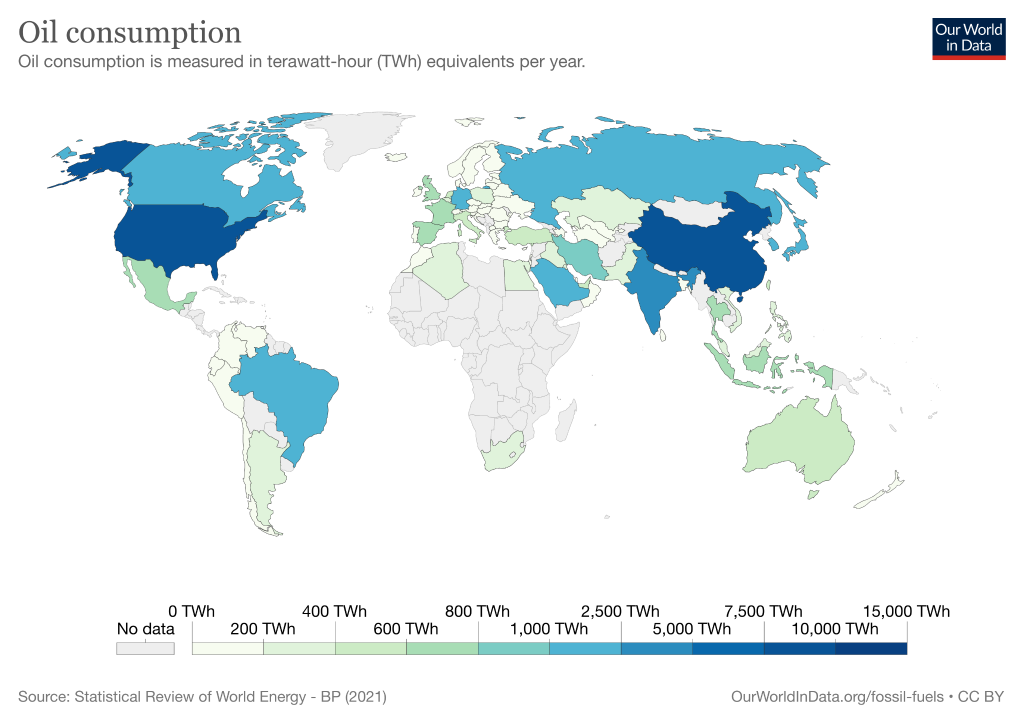
Here are the life-cycle stages of oil energy and each stage’s carbon footprint:
- Building of oil: CO2 emissions from oil extraction and refinement, construction of oil-fired plants, and transportation of oil to refineries and plants
- Operating of oil: CO2 emissions from oil combustion and operation of mechanical equipment at plants
- Building back of oil: CO2 emissions from plugging wells and decommissioning power plants; CH4 seepage from unplugged wells
The world collectively emitted 12.36 billion tons (bt) of CO2 from oil in 2019, and because oil has been one of the most in-demand global fuel sources since the 1920s, it is important to understand what its carbon footprint is and how its carbon emissions affect the global climate change process.
Coal Energy Has the Second Highest Carbon Footprint at 820 Grams of CO2/kWh on a Life-Cycle Basis
Coal energy is produced via the combustion of black or brownish-black sedimentary rock containing energy stored by plants that lived in swampy forests over a hundred million years ago. The 4 main types, or ranks, of coal depend on the type and amount of carbon the coal contains and the amount of heat energy the coal can produce. The ranks are anthracite, lignite, subbituminous, and bituminous coal.
“Coal: a combustible black or dark brown rock consisting mainly of carbonized plant matter, found mainly in underground deposits and widely used as fuel.”
Cambridge Dictionary
On a life-cycle basis, coal emits 820 grams of carbon dioxide (CO2) equivalent per kWh of electricity produced, which is the second-highest out of all of the fuel types.
In 2020, 477 million tonnes (432.7 million tons) of coal were consumed in the United States (US) alone, which represents around 10% of total US energy consumption. While consumption has decreased in the US and European Union (EU), consumption continues to increase in some Asian countries such as China and India.
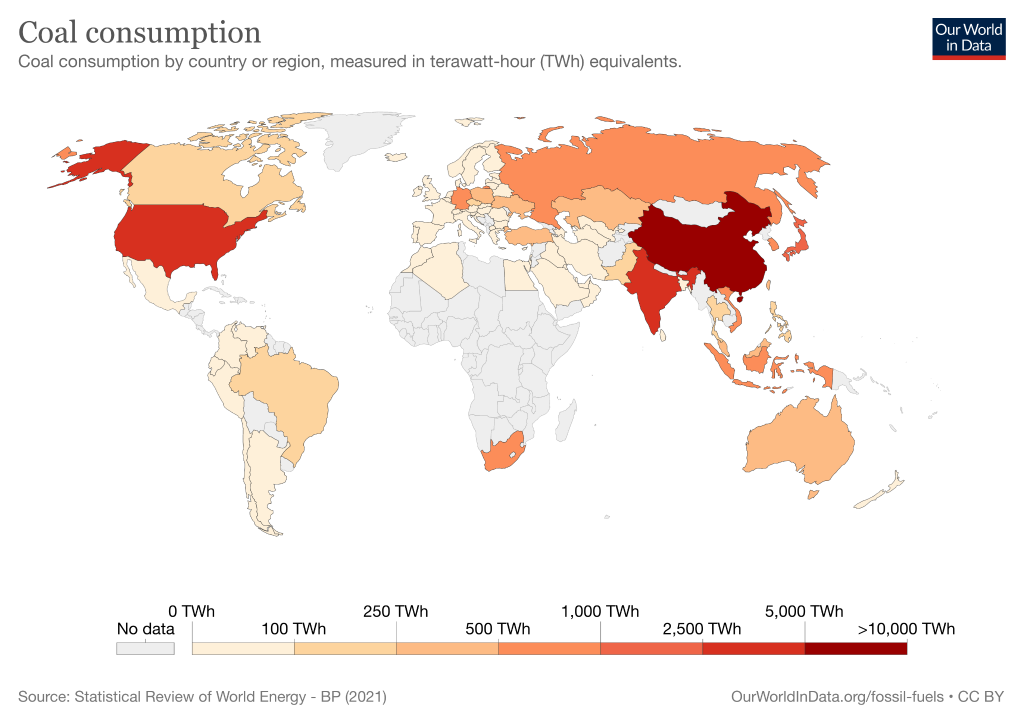
Here are the life-cycle stages of coal energy and each stage’s carbon footprint:
- Building of coal: Mining, construction, and transportation
- Operating of coal: Operation of the coal power plant
- Building back of coal: Shutdown, decommissioning, remediation, and redevelopment
In 2019, the world collectively emitted 14.36 billion tons of CO2 from coal alone, higher than that from all other industries. Because coal remains an important fuel source for the global economy, it is important to understand what its carbon footprint is and how its carbon emissions affect the global climate change process.
Natural Gas Energy Has the Fourth Highest Carbon Footprint at 490 Grams of CO2/kWh on a Life-Cycle Basis
Commonly referred to as the world’s cleanest fossil fuel, natural gas (NG) is a flammable gas composed of mostly methane (CH4), some hydrocarbon gas liquids (HGLs), and nonhydrocarbon gases (CO2 and water vapor). When burned it produces mostly CO2, water vapor, and some nitrogen oxides. NG is acquired in one of two ways, either by conventional (vertical) drilling or by hydraulic fracturing.
“Natural Gas: flammable gas, consisting largely of methane and other hydrocarbons, occurring naturally underground (often in association with petroleum) and used as fuel”
Oxford Dictionary
On a life-cycle basis, NG emits 490 grams of CO2 equivalent per kWh, the third-highest amount out of all of the fuel types, but the lowest out of the three fossil fuels.
In 2020, 30.5 trillion cubic feet (Tcf) of NG were consumed in the US alone. This represents around 34% of total US energy consumption. And since 2010, 80% of NG growth has been concentrated within the US, China, and the Middle East.
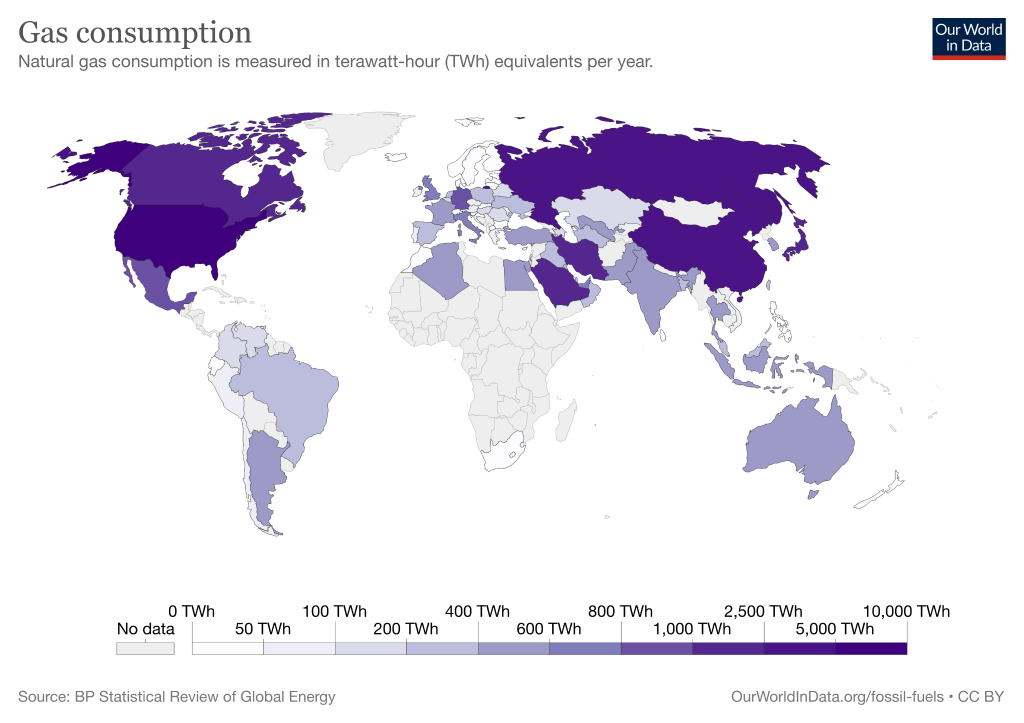
Here are the life-cycle stages of NG energy and each stage’s carbon footprint:
- Building of NG: CO2 emissions from extracting and processing NG, transportation of NG through pipes and on ships, construction of NG power plants
- Operating of NG: CO2 emissions from NG combustion, operation of equipment at NG power plants, and leakage of CH4 from in-service wells
- Building back of NG: CO2 emissions from plugging wells and decommissioning power plants, CH4 seepage from unplugged wells
The world collectively emitted 7.62 billion tons (bt) from NG in 2019, the fewest amount out of the three fossil fuels (i.e. coal, oil, NG). Because NG is the world’s fastest-growing fossil fuel that accounts for around 23% of primary energy demand and 25% of electricity generation, it is important to understand what its carbon footprint is and how its carbon emissions affect the global climate change process.
What Role Do Fossil Fuels Play in Contributing To Climate Change
Climate change is arguably the most severe, long-term, global impact of fossil fuel combustion. Every year, approximately 36 bt of CO2 are emitted from burning fossil fuels. 44% (15.8 bt) of this comes from coal, 34% (12 bt) from oil, and 21% (7.5 bt) from NG. The carbon found in fossil fuels reacts with oxygen in the air to produce CO2. This warms the earth by acting as a heating blanket, and a warmer earth comes with a host of negative side effects.
CO2 emissions contribute to climate change in the following ways:
- Increasing temperatures: Earth’s atmosphere has warmed 1.5℃ since 1880. This may not seem like a lot, but these degrees create regional and seasonal temperature extremes, reduce sea ice, intensify rainfall and drought severity, and change habitat ranges for plants and animals.
- Rising sea levels: Global sea levels have increased approximately 8-9 inches since 1880, displacing people living along coastlines and destroying coastal habitats. Roads, bridges, subways, water supplies, oil and gas wells, power plants, sewage treatment plants, and landfills remain at risk if sea level rise goes unchecked.
- Melting of sea ice: Since 1979 arctic sea ice has declined by 30%. Sea ice plays a major role in regulating the earth’s climate by reflecting sunlight into space and providing habitat for animal species. If all of the glaciers on Earth melted, sea levels would rise by approximately 70 feet, effectively flooding out every coastal city on the planet.
- Changing precipitation patterns: Extreme weather events (e.g., hurricanes, floods, droughts) are becoming more common and more intense. Storm-affected areas will experience increased precipitation and flooding whereas areas located further from storm tracks will experience decreased precipitation and droughts.
- Ocean acidification: The ocean absorbs 30% of the CO2 released into the atmosphere, which decreases the pH (increases the acidity) of the ocean. In the past 200 years, the pH of oceans has decreased by 0.1 pH units, which translates to a 30% increase in acidity. Aquatic life unable to adjust to this rapid acidification will die off. A prime example of this is coral bleaching, where coral expel the algae (zooxanthellae) living in their tissues as a result of changes in temperature, light, or nutrients.
The more we reduce CO2 emissions, the more we slow the rate of temperature rise, sea-level rise, ice melting, and ocean acidification. When these rates are slowed, the earth’s biodiversity does not have to struggle to adapt to temperature and pH changes. People will not be displaced due to the flooding of coastal areas. And icebergs will continue to provide climate regulation.
How Environmentally Friendly are Fossil Fuels
Fossil fuels are our primary energy source, but their combustion produces over 36 bt of CO2 emissions annually which contributes significantly to global climate change.
“Environmentally friendly: (of products) not harming the environment.”
Cambridge Dictionary
Coal, oil, and NG are considered dirty fuel sources because of their high rate of CO2 emissions, toxic heavy metals, and other chemicals that contribute to global climate change. Because of this, the environmental benefits are scarce, and the environmental drawbacks are abundant.
What Are Environmental Benefits of Fossil Fuels
Although fossil fuels do not benefit the environment, there are ways to possibly mitigate their environmental impact. Various methods to do so include:
- Oil: To minimize environmental impacts, technological advances in drilling, production, and transportation of oil as well as strict safety and environmental laws and regulations must be enforced. For example, satellites, GPS, and remote sensing technology can detect oil reserves underground which negates the need to drill many exploratory wells. Also, horizontal and directional drilling allows a single well to produce oil from a much larger area, reducing the overall number of wells needed.
- Coal: Ways to possibly mitigate its environmental impact include desulfurization, carbon capture, and re-use and recycling. For desulfurization, scrubbers are installed in smokestacks to remove sulfur dioxide (SO2) emissions before they enter the atmosphere. For carbon capture, CO2 from coal emissions is separated and recovered in a concentrated stream for later injection underground (sequestration). For re-use, land used for coal mining is reclaimed and repurposed as airports, landfills, and golf courses. For recycling, waste emissions can be used to produce cement and synthetic gypsum for wallboard.
- Natural gas (NG): This is considered the cleanest fossil fuel because it has lower levels of CO2, CO, nitrogen oxides, and SO2 than both coal and oil. However, these emissions and methane still contribute directly to global climate change. The best way to mitigate its environmental impact is to detect, fix, and repair methane leaks from well-pads, processing plants, compressor stations, and large distribution facilities. Doing this can reduce methane output by 1.70-1.80 million metric tons per year.
What Are Environmental Drawbacks of Fossil Fuels
Each of the main fossil fuels has its environmental drawbacks as well as collectively adding to atmospheric CO2 levels and contributing to global warming.
- Oil: Oil spills cause serious environmental harm by contaminating water and soil, causing explosions and fires, and harming wildlife. Oil combustion also releases CO2 and other particulates which can cause respiratory problems. In the case of fracking, large amounts of water and potentially hazardous chemicals are required, which can decrease water availability for people and aquatic life and can result in leaks and spills of fracking fluids. Fracking produces large amounts of wastewater which require treatment before disposal, and injecting it back underground can cause earthquakes that are large enough to be felt.
- Coal: The combustion of coal produces over 14 bt of CO2 emissions every year which contributes significantly to global climate change. Air pollution can cause numerous health problems including asthma, breathing difficulties, brain damage, heart problems, and cancer. Leftover coal ash residue and toxic heavy metals can leach into surface (ponds, lakes) and groundwater ponds, lakes, landfills, and other sites which could eventually lead to the contamination of waterways and drinking water supplies. Methods to burn coal without adding to atmospheric CO2 levels are often expensive and difficult to successfully implement.
- Natural gas (NG): Drilling for NG can disturb vegetation and soil and may require clearing and leveling the area around a well pad. Drilling also produces air pollution and may contaminate water sources via erosion, fracking fluids, equipment runoff, and sedimentation. Erosion and fragmentation of wildlife habitat and migration patterns have also been documented. When NG is burned at well sites, it releases CO2, carbon monoxide (CO), sulfur dioxide (SO2), and nitrogen oxides into the atmosphere. Burning NG instead of releasing it directly into the atmosphere produces lower levels of GHG emissions because CO2 is not as potent as methane, but it still contributes to the overall level of CO2 in our atmosphere.
Overall, burning fossil fuels adds to the total level of CO2 in our atmosphere and expedites global warming.
- Atmospheric CO2: Levels of CO2 in our atmosphere have increased as a result of human emissions since the beginning of the Industrial Revolution in 1750. Emissions increased steadily to 5 bt per year in the mid-20th century before increasing exponentially to more than 35 bt per year at the end of the 20th century. The global average amount of CO2 in the atmosphere was about 280 parts per million (ppm) in 1750 but today registers at over 400 ppm. By the end of the 21st century, this number is expected to exceed 900 ppm. Burning fossil fuels adds to this total, which in turn amplifies the greenhouse effect and causes global warming.
- Global warming: This phenomenon occurs when CO2 and other air pollutants absorb sunlight and solar radiation in the atmosphere, trapping the heat and acting as an insulator for the planet. Since the Industrial Revolution, Earth’s temperature has risen a little more than 1 degree Celsius (C), or 2 degrees Fahrenheit (F). Between 1880-1980 the global temperature rose by 0.07C every 10 years. This rate has more than doubled since 1981, with a current global annual temperature rise of 0.18C, or 0.32F, for every 10 years. Experts claim that to avoid a future plagued by rising sea levels, acidified oceans, loss of biodiversity, more frequent and severe weather events, and other environmental disasters brought on by the hotter temperatures, we must limit global warming to 1.5C by 2040.
The easiest way to mitigate the environmental impact of fossil fuels is to simply not rely on them in the first place. Fossil fuel combustion releases toxic chemicals, heavy metals, CO2, and contributes directly to global warming.
The COVID-19 pandemic and increased interest in cleaner forms of energy such as solar, wind, and hydropower drove global demand for fossil fuels down in 2020.
- Coal demand fell by approximately 7% (500 million tons) between 2018 and 2020.
- Oil demand will grow at an average annual rate of 950 thousand barrels per day (kb/d), a reduction from 1.5mb/d seen over the past decade.
- NG demand saw a 4% drop in 2020 but is expected to recover in 2021 and have a 1.5% average growth rate from 2021-2025.
Final Thoughts
Fossil fuels are the world’s primary energy source and have been for decades. But their high carbon footprint across the building, operating, and building back phases causes significant environmental degradation and contributes heavily to global warming. Oil has the highest CO2 emissions per kWh followed closely by coal and lastly NG. Although NG is touted as a cleaner fossil fuel, it still contributes more CO2 emissions annually than alternative energy sources like solar, wind, and hydropower.
Demand for fossil fuels has fallen in the last decade due to increased interest in these alternative energy sources. Reducing fossil fuel consumption would benefit our health and our planet’s health.
Stay impactful,

Sources
- Environmental and Energy Study Institute: Fossil Fuels
- National Resources Defense Council: Fossil Fuels – the Dirty Facts
- Union of Concerned Scientists: How Coal Works
- US Energy Information Administration: Coal Explained
- US Energy Information Administration: Use of Coal
- US Energy Information Administration: Oil and Petroleum Products Explained
- US Energy Information Administration: Use of Oil
- Statista: Primary energy consumption in the United States in 2019 and 2020, by energy source
- US Energy Information Administration: Natural Gas Explained
- US Energy Information Administration: Use of Natural Gas
- Brittanica: Carbon Footprint
- United States Environmental Protection Agency: System of Registries
- World Nuclear Association: Carbon Emissions from Electricity
- Our World in Data: CO2 emissions by fuel
- Our World in Data: Fossil Fuels
- Forbes: The Ten Countries That Dominate World Fossil Fuel Production
- Science Direct: Life-cycle assessment (LCA)
- MIT SMR: Strategic Sustainability Uses of Life-Cycle Analysis
- McKinsey Sustainability: Climate risk and decarbonization – What every mining CEO needs to know
- Natural Resources Canada: Learn the facts – fuel consumption and CO2
- World Nuclear Association: Where Does Our Electricity Come From?
- US Energy Information Administration: How much carbon dioxide is produced when different fuels are burned?
- US Energy Information Administration: How much carbon dioxide is produced per kilowatthour of U.S. electricity generation?
- US Energy Information Administration: Annual Coal Reports
- Union of Concerned Scientists: Environmental Impacts of Natural Gas
- United States Environmental Protection Agency: Plant decommissioning, remediation and redevelopment
- Nature: Quantifying operational lifetimes for coal power plants under the Paris goals
- Coloradans for Responsible Energy Development: How long does fracking last?
- Bureau of Safety and Environmental Enforcement: Rigs-to-Reefs
- US Energy Information Administration: Natural gas generators make up the largest share of overall U.S. generation capacity
- The National Wildlife Federation: Climate Change
- National Oceanic and Atmospheric Administration: Climate Change – Global Temperature
- National Oceanic and Atmospheric Administration: Climate Change – Global Sea Level
- United States Geological Survey: How would sea level change if all glaciers melted?
- National Aeronautics and Space Administration, U.S.A.: How does climate change affect precipitation?
- National Oceanic and Atmospheric Administration: Ocean Acidification
- National Ocean Service: What is coral bleaching?
- Union of Concerned Scientists: The Hidden Costs of Fossil Fuels
- US Energy Information Administration: Coal and the Environment
- US Energy Information Administration: Oil and the Environment
- NaturalGas.org: Natural Gas and the Environment
- National Resources Defense Council: Reducing Natural Gas Leakage to Protect the Environment Is Easy to Do, Saves Money, and Creates Jobs
- Union of Concerned Scientists: Coal Power Impacts
- National Oceanic and Atmospheric Administration: Climate Change – Atmospheric Carbon Dioxide
- US Energy Information Administration: Natural Gas and the Environment
- National Resources Defense Council: Global Warming 101
- International Energy Agency: Coal 2020
- International Energy Agency: Oil 2020
- International Energy Agency: Gas 2020




